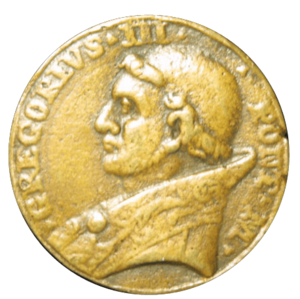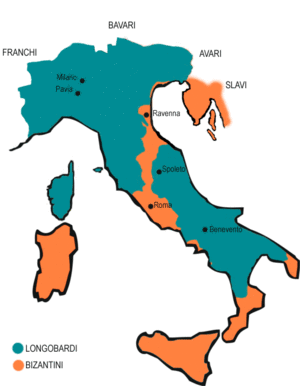Pope Gregory III facts for kids
Quick facts for kids Pope Saint Gregory III |
|
|---|---|
| Bishop of Rome | |

Effigy of Pope Gregory III in a c. 8th century medal
|
|
| Church | Catholic Church |
| Papacy began | 11 February 731 |
| Papacy ended | 28 November 741 |
| Predecessor | Gregory II |
| Successor | Zachary |
| Orders | |
| Created Cardinal | 726 |
| Personal details | |
| Born | Syria, Umayyad Caliphate |
| Died | 28 November 741 Rome, Exarchate of Ravenna |
| Previous post | Cardinal-Deacon (726-31) |
| Sainthood | |
| Feast day | 10 December |
| Venerated in | Roman Catholic Church Eastern Orthodox Church |
| Other Popes named Gregory | |
Pope Gregory III (who died on November 28, 741) was the bishop of Rome from February 11, 731, until his death. During his time as pope, he faced challenges from the Byzantine practice of iconoclasm (destroying religious images) and the growing power of the Lombards, a Germanic people in Italy. He asked for help from Charles Martel, a powerful Frankish leader, but it didn't fully solve the problems.
Gregory III was the last pope to need approval from the Byzantine governor (called an exarch) in Ravenna before his election was official. He was also the last non-European pope for more than 1,271 years, until Pope Francis was elected in 2013.
Contents
Becoming Pope
Gregory was the son of a man named John from Syria. He was chosen as pope by a large group of people on February 11, 731. However, he wasn't officially made the bishop of Rome until March 18, after he received approval from the Byzantine exarch (governor) in Ravenna. He was the last pope who had to get this approval from the exarch after being elected.
Fighting Iconoclasm
Right after becoming pope, Gregory asked Emperor Leo III to change his mind about iconoclasm. Iconoclasm was a belief that religious images (icons) should be destroyed. When Gregory's messenger was arrested by the emperor's orders, Gregory called a special church meeting (a synod) in November 731. At this meeting, they strongly spoke out against iconoclasm.
Emperor Leo tried to control the pope, but the ships he sent to Rome were destroyed in a storm at sea. The emperor then took church lands in Sicily and Calabria. He also moved control of churches in some areas to the patriarch of Constantinople. However, his attempt to make the duke of Naples take church land in his area failed, because the duke supported the pope.
Meanwhile, Gregory showed his strong opposition to iconoclasm. He did this by showing great respect for icons and holy objects. He repaired and made many churches more beautiful. This included decorating them with icons and images of Jesus Christ, the Virgin Mary, and the saints. He also built a new place for prayer in St. Peter’s Basilica to keep holy objects of saints. He called another meeting in 732 to set rules for prayers and church services there. Gregory was also a big supporter of monasticism (monks and nuns). He started a monastery and rebuilt a place for helping the poor near St. Peter's.
Church Leadership
A short break in the fighting between the Byzantines and the Lombards allowed Gregory to focus on other church matters. One issue was a long-standing disagreement between the leaders of the churches in Grado and Aquileia. Even though a church meeting in 731 had decided in favor of Grado, Gregory had to warn the leader of Aquileia, Calixtus. Calixtus had tried to take control of an island called Barbana from Grado.
In 731, Gregory approved the choice of Tatwine as the archbishop of Canterbury in England. Tatwine had traveled to Rome to ask for a special scarf called a pallium, which showed his authority. Gregory also approved the next archbishop, Nothhelm. In 735, he agreed to the request of King Ceolwulf of Northumbria that Bishop Egbert of York should become an archbishop.
Gregory also worked to spread the Church in northern Europe. He strongly supported the work of Saint Boniface in Germany. In 732, he made Boniface an archbishop in Germany. After Boniface visited Rome in 737, Gregory made him a special representative (a papal legate) in Germany. He asked Boniface to organize the church areas (called episcopal sees) there. Gregory sent Boniface back to Bavaria with three letters. One letter told bishops and church leaders to help Boniface. Another letter asked the nobles and people of Germany to obey Boniface. The third letter, sent to bishops in Alamannia and Bavaria, confirmed Boniface's role as the pope's representative. It told them to meet twice a year under Boniface's leadership. Gregory also supported the mission of Willibald in Germany.
In 732, Gregory banned people from eating horse meat, both from wild and farm horses. He called it an "abomination" because it was linked to pagan religious feasts.
The Lombard Threat
Knowing the Lombards were a constant danger, Gregory worked to repair and finish the Aurelian Walls around Rome in the early 730s. He also made the city of Centumcellae stronger. He bought back the fortress of Gallese from Thrasimund II of Spoleto. This fortress, which the Lombards had taken, was important because it cut off Rome's communication with the Byzantine governor in Ravenna. When the Lombard king Liutprand returned in 737, the Lombards started attacking the Byzantine area of Ravenna again.
Even though Gregory disagreed with the Byzantine emperor about iconoclasm, he still helped the Byzantines. He supported them in taking back Ravenna after the Lombards captured it around 738. In the same year, Liutprand ordered the Lombard dukes of Spoleto and Beneventum to attack the area around Rome. But both dukes refused, saying they had a peace agreement with the pope. Gregory then actively encouraged Thrasimund to rebel. This forced Liutprand to stop attacking the Byzantine area and focus on Spoleto, which Liutprand then took over. Thrasimund had to run away from Spoleto and found safety in Rome, where Gregory welcomed him.
By mid-739, Liutprand was again threatening the Byzantine area and Rome itself. In desperation, Gregory sent messengers to Charles Martel, the powerful Frankish leader. He begged Charles to help the pope. Gregory even said he was willing to stop being loyal to the Eastern Roman Empire and place himself under the Franks' protection. However, Charles didn't promise to help, because he was busy fighting the Umayyad Muslims (who Gregory called a "most fierce nation").
This time, Charles Martel did send messengers to Rome. This quiet support, along with his troops getting sick, forced Liutprand to go back to Pavia by the end of August 739. Taking advantage of this, Gregory agreed to help Thrasimund II return to Spoleto. Thrasimund II fought his way back into Spoleto by December 739 with help from Roman soldiers. But he refused to give back four captured towns he had promised in exchange for the pope's support. When Liutprand learned that Charles Martel was sick, he started attacking the Byzantine area again in 740. Gregory had to ask the Franks for help again, but they still refused to get involved.
Death
Gregory III was not successful in stopping the Lombard attacks. He died on November 28, 741. Pope Zachary became the next pope. Gregory was buried in St. Peter’s Basilica, in the prayer room he had built at the beginning of his time as pope. Gregory’s feast day is now celebrated on December 10.
Sources
- Levillain, Philippe (2002). The papacy : Gaius-Proxies. New York: Routledge. ISBN 9780415922302. https://archive.org/details/papacy00phil.
- Duffy, Eamon (2006). Saints & Sinners: A History of the Popes. New Haven, Conn.: Yale University Press. ISBN 9780300115970. https://archive.org/details/00book1593273669.
- Treadgold, Warren (1997). A History of the Byzantine State and Society. Stanford, California: Stanford University Press. ISBN 978-0804726306.
- Mann, Horace K. (1914). The Lives of the Popes in the Early Middle Ages. I: The Popes Under the Lombard Rule, Part 2, 657-795. pp. 203–224. https://archive.org/stream/livesofpopesinea12mann#page/202/mode/2up.
| Catholic Church titles | ||
|---|---|---|
| Preceded by Gregory II |
Pope 731–741 |
Succeeded by Zachary |
See also
 In Spanish: Gregorio III para niños
In Spanish: Gregorio III para niños


